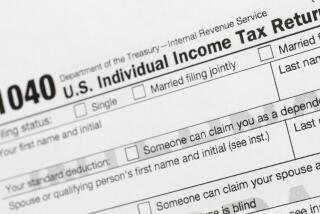Tight on cash? Redeem those old savings bonds
- Share via
Looking for cash to tide you over during these lean times? The Treasury Department is urging Americans to quiz their parents and grandparents this holiday season about whether they squirreled away U.S. savings bonds that have stopped earning interest.
The reason: About $16 billion of these bonds haven’t been redeemed.
The government suspects that the owners have either died or forgotten about the investments that they bought in the 1940s, ‘50s, ‘60s and ‘70s.
Some of them are engraved certificates suitable for framing. But if you find one gathering dust in Grandma’s attic, know that it is worth much more than its face value -- perhaps almost 10 times as much.
In other words, a bond that says it’s worth $100 could be worth nearly $1,000. But don’t be fooled into thinking that the oldest ones are the most precious.
A $100 bond issued in January 1943, which stopped earning interest in 1983, is worth just $399.80. But a $100 bond issued in January 1965, which earned a more generous rate until 2005, is worth a cool $936.44.
Bonds issued after 1965, however, earned interest for just 30 years. As a result, a $100 bond issued in January 1966 is worth just $512.52 today -- a bit more than half the value of the bond issued a year before.
If your search turns up a bond certificate, you can find out how much it is worth with the Treasury Department’s savings bond calculator at www.TreasuryDirect.gov.
You can plug in the bond’s serial number, or enter the bond series (EE, E, I or “savings note”) and the month and year the bond was issued.
The resulting chart will show the original purchase price and how much it’s currently worth. If the bond is still earning interest, the chart also will tell you the interest rate.
If you have multiple bonds -- millions of people bought as many as a dozen bonds a year through payroll deductions -- you can keep plugging in bond numbers or issue dates and the calculator will create a running tally.
If you have misplaced a savings bond, you can use the Treasury Hunt tool on the TreasuryDirect website, which searches using the owner’s Social Security number.
If you find a bond through Treasury Hunt, your next step is to ask the government to replace it or to send you the amount of money it’s worth. To do that, you must submit a form called PD F 1048, which you can either download from the website or receive by mail after making a request through the website.
Treasury Hunt, however, goes back only to 1974. If you’re convinced that you own a bond purchased before then, you need to fill out the PD F 1048 form to have the Treasury search its paper files.
If you suspect your late parents or grandparents owned savings bonds, you can find out by entering their Social Security numbers into the Treasury Hunt tool. If that turns up any unredeemed bonds, you’ll need to go through the same process as if you’d lost a bond.
But in this case the Treasury will ask for additional documentation to show that you are the rightful heir, said Stephen Meyerhardt, spokesman for the savings bond program.
If there are multiple heirs, another form on the Treasury’s website allows you to ask for the bond’s value to be divided and for each share be sent to its owner.
If you’re looking for the fastest way to get cash for your savings bonds, take them to a local bank, credit union or savings and loan. Most serve as redemption agents for savings bonds.
At a time when money is scarce, Meyerhardt said, make sure you’re not sitting on bonds that are no longer earning interest.
“Some people know they have them, but they don’t want to cash them in for some reason,” he said. “These are registered government securities, and we stand ready to replace them or cash them out to the person who is entitled at any time.”
--
More to Read
Inside the business of entertainment
The Wide Shot brings you news, analysis and insights on everything from streaming wars to production — and what it all means for the future.
You may occasionally receive promotional content from the Los Angeles Times.










